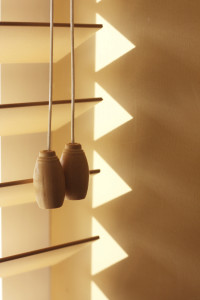25 Mar The Pros and Cons of Real vs. Faux Wood Blinds
 Blinds are one of the most common, if not the most common, window coverings we use in our homes and offices. Often, blinds are chosen for practicality and function rather than aesthetics. In some situations, that’s fine. More often, you want to take care to pick something helps create the overall feel and look of the room you are furnishing. Many people like the look of wood blinds but aren’t sure whether real or faux wood is the best choice for them. We’ll discuss the differences between real and faux wood blinds to help you decide which is right for you.
Blinds are one of the most common, if not the most common, window coverings we use in our homes and offices. Often, blinds are chosen for practicality and function rather than aesthetics. In some situations, that’s fine. More often, you want to take care to pick something helps create the overall feel and look of the room you are furnishing. Many people like the look of wood blinds but aren’t sure whether real or faux wood is the best choice for them. We’ll discuss the differences between real and faux wood blinds to help you decide which is right for you.
Genuine wood blinds
Pros: Genuine wood blinds are crafted of hardwood, most often basswood. Hardwood blinds have an elegant, timeless look that is visually appealing in almost any setting. Wooden blinds are lighter in weight than their faux counterparts, making them easier to open and close, raise and lower. Because of their lighter weight, real wood blinds may be available in longer spans than their faux wood counterparts. Genuine wood blinds are stained or painted and are available in a variety of colors, and since they’re made of real wood, they look like real wood.
Cons: Wood blinds aren’t as flexible as faux wood blinds. If your blinds are going to be around children or pets, they may receive abuse that can cause them to crack or split. Genuine wood blinds are not recommended in areas with high humidity, as it can cause them to warp. Wood blinds are also more expensive than many versions of faux wood blinds. Depending on the size and quality, they may cost a few hundred dollars more.
Faux wood blinds
Pros: Faux wood blinds are called faux wood because they are designed to look like wood, rather than the vinyl or aluminum slats. Faux wood blinds are crafted of a composite material that often has an embossed wood grain. Faux wood blinds are available in a variety of colors, so you’ll be able to find just the right shade. Because they are engineered of synthetic materials, these blinds stand up better to the humid conditions in bathrooms and kitchens better than real wood. Some composite wood blinds are available in stock in the most common sized at home improvement stores, making them more convenient than custom orders. Faux wood blinds are also generally more affordable than their genuine wood counterparts.
Cons: Faux wood is faux wood, so it doesn’t have the same richness that you can get from high-end genuine wood blinds. The embossed wood grain can collect more dust and make the slats more difficult to clean. They are generally much heavier then wood blinds, and you may need to or more sections in order to cover a particularly wide span.
Of course the most important considerations when choosing your blinds are your taste, budget, and lifestyle. Talking to a window coverings specialist will help you determine which type of blinds will best fit your needs.

Sorry, the comment form is closed at this time.